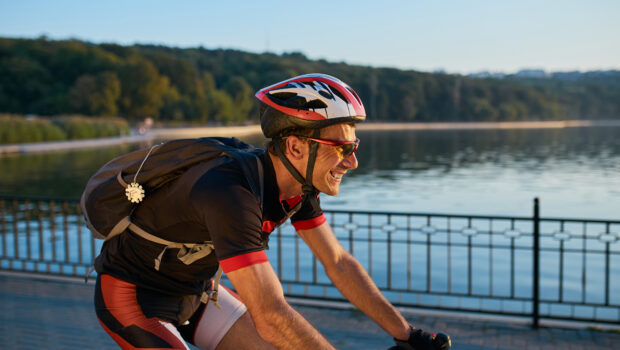Beyond the Finish Line: Exploring the World of Triathlons
Triathlon, a testament to human endurance and multifaceted athleticism, stands as one of the most challenging and rewarding sporting endeavors. A triathlon is a multisport race that combines three distinct disciplines: swimming, cycling, and running. Athletes, known as triathletes, showcase their physical prowess as they seamlessly transition from one segment to another, demanding a unique blend of cardiovascular fitness, strength, and mental resilience.
As a triathlete stands at the starting line, they are embarking on a journey that will test not only their physical capabilities but also their ability to strategize and persevere through diverse terrains and conditions. The triathlon is not merely a race; it’s an intricate dance between the elements, pushing the boundaries of what the human body can achieve.
History of Triathlons
The roots of the triathlon can be traced back to the early 1970s, a time when a group of athletes sought to settle a friendly debate over which endurance sport—swimming, cycling, or running—demanded the most rigorous training. The result was the creation of the first modern triathlon, an event held on September 25, 1974, in San Diego, California. Organized by the San Diego Track Club, this inaugural race consisted of a 6-mile run, a 5-mile cycle, and a 500-yard swim in the Pacific Ocean.
The pioneers of this sport, including Jack Johnstone, Don Shanahan, and Dave Pain, were driven by a shared passion for pushing physical boundaries and exploring new dimensions of athleticism. What started as a friendly challenge soon evolved into a global phenomenon, captivating the imaginations of fitness enthusiasts worldwide.
The 1980s marked a period of rapid growth for triathlons, with the establishment of the International Triathlon Union (ITU) in 1989, further solidifying the sport’s place on the international stage. Triathlons were included in the Olympic Games in 2000, providing a platform for elite athletes to showcase their skills and inspiring a new generation of enthusiasts.
The evolution of triathlons reflects a synergy between tradition and innovation. While the essence of swimming, cycling, and running remains at the core, technological advancements, training methodologies, and a growing community of participants continue to shape the sport’s trajectory. Today, triathlons encompass a wide range of distances and formats, accommodating beginners and seasoned athletes alike.
The rich history of triathlons not only showcases the evolution of a sport but also the indomitable spirit of those who embraced the challenge, transforming it from an experimental endeavor to a global sporting phenomenon. In the subsequent sections, we will delve into the different types of triathlons that have emerged, each offering a unique experience and presenting athletes with distinct sets of challenges and triumphs.
Choosing the Right Triathlon
Define Your Why
Before delving into the specifics of race distances and formats, take a moment to reflect on why you want to participate in a triathlon. Is it a personal challenge, a fitness goal, or perhaps a desire to be part of a vibrant community? Understanding your motivation lays the foundation for a meaningful and fulfilling journey.
Consider Fitness Levels
Triathlons come in various distances, catering to a spectrum of fitness levels. If you’re new to the sport or returning after a hiatus, a Sprint Triathlon with shorter distances might be an ideal starting point. For those with more experience and endurance, Olympic or IRONMAN distances could provide the ultimate challenge. Assess your current fitness levels realistically and choose a race that aligns with your capabilities.
Factor in Time Commitments
Training for a triathlon demands time and dedication. Consider your daily schedule, work commitments, and family responsibilities. Opt for a race that allows you to balance training with other aspects of life. Sprint triathlons, with their relatively shorter training requirements, might be more accessible for those with busy lifestyles.
Set SMART Goals
Make your goals Specific, Measurable, Achievable, Relevant, and Time-bound (SMART). Whether it’s completing a race without stopping, achieving a personal best time, or mastering a particular discipline, setting SMART goals provides a roadmap for your training journey and keeps you accountable.
Account for Progression
Triathlons can become a lifelong pursuit, and progression is key. If you’re new to the sport, consider starting with a shorter distance and progressively challenging yourself as you gain experience and confidence. This incremental approach ensures a sustainable and enjoyable journey.
Training for a Triathlon
Training for a triathlon is a comprehensive process that requires a strategic and well-rounded approach. The integration of swimming, cycling, and running into a cohesive training plan demands attention to various facets of fitness, technique, and mental resilience. As you embark on your training journey, consider these general principles that form the bedrock of triathlon preparation:
Periodization
Triathlon training typically follows a periodized structure, dividing the training cycle into distinct phases. These phases include the preparation or base phase, the build phase focusing on intensity and specificity, and the taper phase leading up to the race. Periodization allows for systematic progression, preventing burnout and optimizing performance.
Consistency is Key
Triathlon training is about building endurance over time. Consistency in training is paramount. Establish a training schedule that aligns with your goals and commitments, ensuring a steady progression of fitness levels. Regular, purposeful training sessions contribute significantly to overall performance improvement.
Balance the Disciplines
While each discipline requires specific attention, maintaining a balanced approach to training is crucial. Devote adequate time to swimming, cycling, and running to ensure that your overall fitness is well-rounded. This balance not only enhances your performance but also helps prevent overuse injuries associated with focusing too much on a single discipline.
Quality Over Quantity
Triathlon training is not just about accumulating miles. Emphasize the quality of your workouts over sheer volume. Incorporate structured interval sessions, technique drills, and strength training to enhance your efficiency and power in each discipline. Quality training sessions also help optimize recovery.
Cross-Training
Triathletes often benefit from cross-training activities that complement the three main disciplines. Activities like strength training, yoga, and flexibility exercises contribute to overall fitness, reduce the risk of injuries, and add variety to your training routine.
Recovery is Essential
Adequate recovery is as vital as the training itself. Triathlon training places considerable stress on the body, and recovery allows for adaptation and growth. Ensure sufficient sleep, incorporate rest days into your schedule, and consider techniques such as massage, stretching, and foam rolling to support recovery.
Mental Preparedness
Triathlons are not just physical challenges; they are mental tests as well. Develop mental resilience through visualization, positive self-talk, and race simulation. Mental preparedness is a valuable asset during challenging moments in a race.
Nutrition and Hydration
Fueling your body adequately is a critical aspect of triathlon training. Understand your nutritional needs, stay hydrated, and practice your race-day nutrition strategy during training to ensure optimal performance.
Equipment and Gear
As a multisport event that incorporates swimming, cycling, and running, triathlons demand a specific set of equipment and gear to ensure both performance and safety. Whether you’re a novice or an experienced triathlete, having the right gear is crucial. Here’s a breakdown of the essential equipment for all triathlons:
Swim Gear
Swimsuit: Choose a snug-fitting swimsuit that provides minimal drag in the water. Triathlon-specific suits are designed to dry quickly for the cycling and running segments.
Goggles: Invest in high-quality, anti-fog goggles that offer a comfortable fit and clear vision. Test them in the pool before race day.
Swim Cap: Triathlon events often provide swim caps for identification, but having your own is recommended for practice. It also helps with warmth and reducing drag.
Bike Gear
Bike: Select a road or triathlon bike that suits your budget and preferences. Road bikes are versatile, while triathlon bikes offer aerodynamic advantages. Ensure your bike is properly fitted to optimize comfort and performance.
Helmet: Safety is paramount. Choose a well-ventilated, aerodynamic helmet that meets safety standards. Helmets are mandatory in all triathlons.
Cycling Shoes: Invest in cycling shoes with cleats that attach to your pedals. They enhance pedaling efficiency and transition smoothly to the running segment.
Run Gear
Running Shoes: Choose running shoes based on your running style, foot shape, and the type of terrain. Ensure they are comfortable for both short and long distances.
Race Belt: A race belt allows you to easily attach your race number without damaging your clothing. It’s a practical accessory for smooth transitions.
Transition Gear
Triathlon Suit: A one-piece or two-piece triathlon suit minimizes transitions and provides comfort for all three disciplines. It’s designed to dry quickly and often has padding for cycling.
Towel and Transition Mat: Lay out a small towel and/or transition mat in the transition area for a clean surface to stand on and to quickly dry your feet.
Miscellaneous Gear
Sunglasses: Protect your eyes from the sun, wind, and debris during the cycling and running segments.
Sunscreen: Apply a water-resistant, sweat-proof sunscreen to protect your skin from harmful UV rays.
Hydration System: Depending on the race distance and personal preferences, consider a hydration belt, water bottles on your bike, or a hydration backpack.
Optional Gear
Wetsuit: In colder water temperatures, a wetsuit provides buoyancy and insulation. Check race regulations, as some events have specific rules regarding wetsuit use.
Aero Bars: For longer-distance triathlons, aero bars can enhance aerodynamics and reduce fatigue during the cycling segment.
Before race day, practice with your gear to ensure comfort and familiarity. Being well-prepared with the right equipment contributes significantly to a smooth and enjoyable triathlon experience.
Nutrition and Hydration
In the realm of triathlons, where the body is pushed to its limits across three demanding disciplines, proper nutrition is not just a key factor—it’s the fuel that drives performance and ensures endurance. The importance of maintaining a well-balanced and tailored nutrition plan cannot be overstated, as it directly influences energy levels, recovery, and overall race-day success.
Fueling Energy Demands
Carbohydrates: The primary fuel for endurance activities, carbohydrates are essential for maintaining energy levels throughout the race. Ensure that your pre-race meals include complex carbohydrates such as whole grains, fruits, and vegetables.
Proteins: Critical for muscle repair and recovery, proteins should be part of your overall nutrition plan. Include lean sources such as poultry, fish, beans, and legumes.
Healthy Fats: While carbohydrates are the main energy source, incorporating healthy fats provides a secondary fuel reserve. Avocado, nuts, and olive oil are excellent sources.
Hydration Strategies
Pre-Hydration: Begin hydrating well before race day. Adequate pre-hydration ensures that you start the race in a hydrated state. Water, sports drinks, and electrolyte solutions can contribute to pre-hydration.
During the Race: Depending on the race distance and environmental conditions, establish a hydration plan that includes regular intake of fluids. Sports drinks with electrolytes help replenish sodium lost through sweat, especially during the cycling and running segments.
Post-Race Hydration: Rehydration is crucial for recovery. Consume a combination of water and electrolytes to replace fluids lost during the race. Monitor urine color as an indicator of hydration status.
Timing and Composition
Pre-Race Meal: Consume a balanced meal 2-3 hours before the race, focusing on carbohydrates, moderate protein, and low fat. This provides a readily available energy source without causing digestive discomfort.
During the Race: Incorporate easily digestible snacks, gels, or energy chews during longer races to maintain energy levels. Experiment with different options during training to identify what works best for you.
Post-Race Nutrition: The post-race window is crucial for recovery. Consume a meal or snack containing carbohydrates and protein within the first 30-60 minutes to replenish glycogen stores and support muscle repair.
Individualized Nutrition Plans
Experiment in Training: Triathletes are unique, and nutritional needs can vary. Use training sessions to experiment with different foods, hydration strategies, and timing to understand what suits your body best.
Consider Dietary Restrictions: For those with dietary restrictions or preferences, such as vegetarian or vegan diets, ensure that your nutrition plan meets your specific needs. Consult with a nutritionist if necessary.
Avoid Overeating and Undereating
Balanced Intake: Avoid the temptation to overeat the night before the race, as this can lead to discomfort. Instead, focus on balanced meals throughout the days leading up to the event.
Caloric Deficits: Triathletes should be mindful of not creating significant caloric deficits, as this can lead to fatigue, decreased performance, and compromised immune function.
Proper nutrition is not just a race-day consideration; it is an integral part of your overall training plan. Consistency in maintaining a well-balanced diet, personalized to your needs, will contribute to sustained energy levels and improved performance. In the subsequent sections, we will explore specific nutrition strategies for each phase of a triathlon and address considerations for different race distances.
Conclusion
As we conclude our exploration into the dynamic world of triathlons, it is essential to recap the diverse landscape of this multisport discipline, which caters to athletes of varying aspirations and capabilities.
Sprint Triathlon
Distances: 750m swim, 20km bike, 5km run.
Ideal Participants: Beginners, those with time constraints, or those seeking a fast-paced challenge.
Notable Features: Sprint triathlons provide an accessible entry point into the sport, emphasizing intensity and a shorter time commitment.
Olympic Triathlon
Distances: 1.5km swim, 40km bike, 10km run.
Ideal Participants: Intermediate athletes looking to progress from sprint distances or those seeking a balanced challenge.
Notable Features: Olympic triathlons strike a balance between speed and endurance, testing athletes across longer distances in each discipline.
IRONMAN Triathlon
Distances: 3.8km swim, 180km bike, 42.2km run.
Ideal Participants: Elite athletes, seasoned triathletes seeking the ultimate challenge, or those with a passion for long-distance endurance events.
Notable Features: IRONMAN triathlons epitomize the pinnacle of endurance racing, requiring mental fortitude and extensive training commitment.
In choosing a triathlon, athletes align their goals with the respective distances, recognizing that each type offers a unique set of challenges and rewards. The journey into triathlon extends beyond the physical exertion; it is a transformational experience that fosters resilience, discipline, and a sense of community.
As you embark on your triathlon journey, consider the rich history of the sport, the strategic nuances of training, the significance of proper nutrition, and the gear essential for success. Triathlons are not merely races; they are a celebration of human potential, a tapestry of commitment woven by individuals driven to explore the limits of their capabilities.
The triathlon community, with its camaraderie and shared passion, welcomes athletes of all backgrounds and abilities. Whether you’re aiming for a podium finish or simply challenging yourself to cross the finish line, the triathlon journey is a personal odyssey that promises growth, self-discovery, and a sense of accomplishment.
In closing, remember that the triathlon is not about the destination but the transformative journey it unfolds. As you dive into the water, pedal through the miles, and conquer the run, savor each moment, for in the pursuit of triathlon, you are not merely racing against others; you are forging a path toward the best version of yourself.
Learn more about what is a triathlon?
Header image source click here

















Very Informative Article And also Very Easy to understand. i hope you will keep posting this type of article. THANK…